
Dimdima
Online Children's Magazine from India

Dimdima
Online Children's Magazine from India

The Andamans comprise four main groups of islands North, Middle, South and Little Andamans.
Quite close to North Andamans are two uninhabited islands formed by volcanoes - the islands of Barren and Narcondam. The Andamanese name for Barren island is Molatarchona or 'Smoke Island'. The 608m high volcano that rises abruptly from the sea is the country's only active volcano.
It erupted in 1991 after being dormant for nearly 200 years.
The volcano that formed Narcondam is extinct.
Port Blair, the capital of this tropical paradise, is in South Andamans. It is the landing point of the archipelago. Dolphins greet ships arriving at the Haddo harbour, Port Blair's main harbour, and amuse passengers with their delightful pranks.
Port Blair was named after Archibald Blair, a British surveyor who in 1789 chose this place as the site for the East India Company to start a settlement.
The Japanese occupied the islands around 1942 during World War II. Their brief rule left a lasting impact on the islands - the concrete bunkers seen at vantage points all over the islands were built by them; the fruits and edible crops that they introduced, continue to thrive and there are many locals who can speak Japanese fluently.
Several Indians migrated to the Andamans soon after independence and settled down in Port Blair. Among them Bengalis are the largest single linguistic group and Tamilians, the second largest.
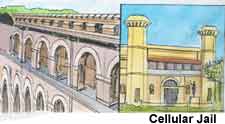 The most prominent place in Port Blair is the Cellular Jail, so called because it had only cells - 698 in all and not a single dormitory.
The most prominent place in Port Blair is the Cellular Jail, so called because it had only cells - 698 in all and not a single dormitory.
It was built between 1886 and 1906 by the British to house dangerous criminals. Later freedom fighters and revolutionaries were imprisoned there. Today it is a national monument.
Port Blair has one of the oldest and largest saw mills in Asia - the Chatham Saw Mills. Its showroom in Haddo exhibits some of the best species of wood in the world.
Ross Island, once the seat of British administration, is a few kilometres away from Port Blair. The island was abandoned after it was hit by an earthquake.
Chiriya Tapu (Bird Island) is about 26km away from Port Blair. It is a bird watcher's paradise. The island abounds in the highly prized edible swiftlets' nests. It was to collect these nests that peopie from Burma and other countries frequented the island. But along with the nests, they also captured natives and sold them as slaves. This made the islanders hostile and fearful of outsiders.
The most hostile of the tribal islanders are the Jarawas and the Sentinelese. The Jarawas number around 200 and live mostly on the west coast of South and Middle Andamans. They are hunters and live like the people of the Stone Age did a thousand years ago. The Sentinelese live on North Sentinel Island. They do not allow anyone to come in close contact with them. They are among the most isolated human communities in the world.
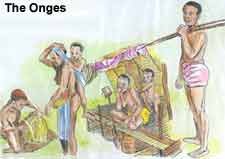 The dwindling group of Onges are found mostly at Dugong creek in Little Andaman. Both men and women keep their heads clean shaven and decorate their face and body with clay. They enjoy smoking pipes made from crab's claws.
The dwindling group of Onges are found mostly at Dugong creek in Little Andaman. Both men and women keep their heads clean shaven and decorate their face and body with clay. They enjoy smoking pipes made from crab's claws.
The Andamanese now cultivate land and have given up their nomadic way of life.
All the four main tribes, Jarawas, Sentinelese, Onges and Andamanese belong to the negrito stock.
The Nicobar Islands are separated from the Andamans by the Ten Degree Channel, considered one of the most turbulent and dangerous channels in the world. Though only 195km away from each other, the two groups of Islands have no common  culture. The Nicobar islands are much smaller. Of the 19 islands only 12 are inhabited. Great Nicobar is the largest island in Nicobar; Nancowry, the most developed; and Car Nicobar to the north, the most densely populated island.
culture. The Nicobar islands are much smaller. Of the 19 islands only 12 are inhabited. Great Nicobar is the largest island in Nicobar; Nancowry, the most developed; and Car Nicobar to the north, the most densely populated island.
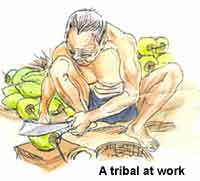 Car Nicobar is a hilly island inhabited by the friendly Nicobari tribe and the shy Shompens, both of Mongoloid origin. Nicobaris live in dome-shaped structures that stand on stilts and climb to their houses with the help of ladders.
Car Nicobar is a hilly island inhabited by the friendly Nicobari tribe and the shy Shompens, both of Mongoloid origin. Nicobaris live in dome-shaped structures that stand on stilts and climb to their houses with the help of ladders.
The Shompens, live in the dense forests of Great Nicobar, the southernmost 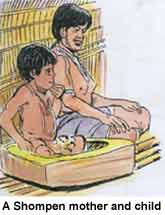 island of Nicobar. Strompens, who have a weakness for honey, have perfected the art of extracting it without hurting themselves. Before approaching a beehive, they chew the leaves of a certain plant and smear a paste made from the leaves on their arms and faces.
island of Nicobar. Strompens, who have a weakness for honey, have perfected the art of extracting it without hurting themselves. Before approaching a beehive, they chew the leaves of a certain plant and smear a paste made from the leaves on their arms and faces. 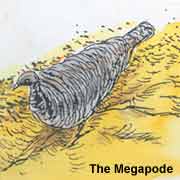 This prevents bees from stinging them.
This prevents bees from stinging them.
On the west coast of Great Nicobar is the small island of Megapode named after the rare birds called Megapodes that nest here.
Pygmalian Point, also known as Indira Point is at the southernmost tip of the island, barely 150km away from the Indonesian island of Sumatra. Besides being the southernmost tip of the entire archipelago, it is also the southernmost tip of India and the end of our long journey along the coast.
Last updated on :5/28/2021
Dimdima is the Sanskrit word for ‘drumbeat’. In olden days, victory in battle was heralded by the beat of drums or any important news to be conveyed to the people used to be accompanied with drumbeats.
Bharatiya Vidya Bhavan
K. M Munshi Marg,
Chowpatty, Mumbai - 400 007
email : editor@dimdima.com
Bharatiya Vidya Bhavan
505, Sane Guruji Marg,
Tardeo, Mumbai - 400 034
email : promo@dimdima.com
Dimdima.com, the Children's Website of Bharatiya Vidya Bhavan launched in 2000 and came out with a Printed version of Dimdima Magazine in 2004. At present the Printed Version have more than 35,000 subscribers from India and Abroad.